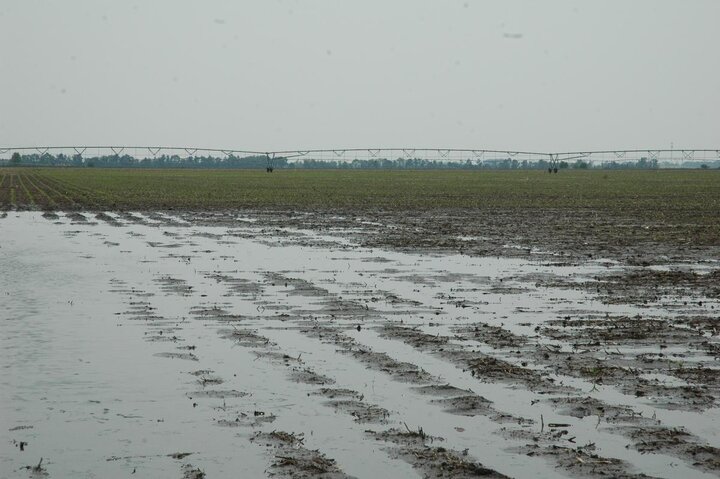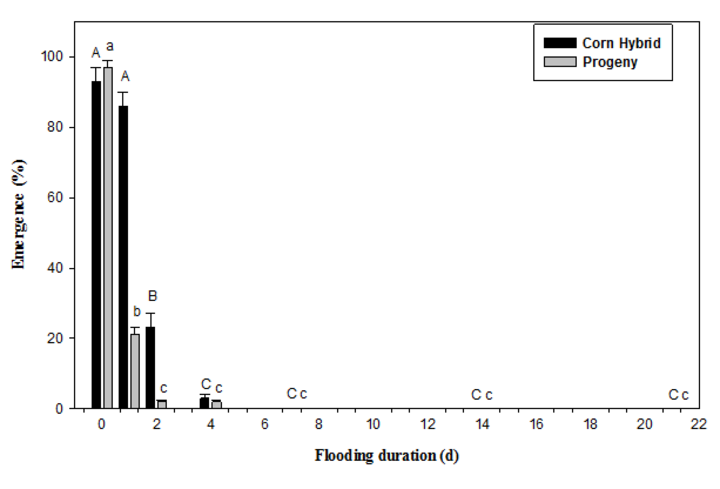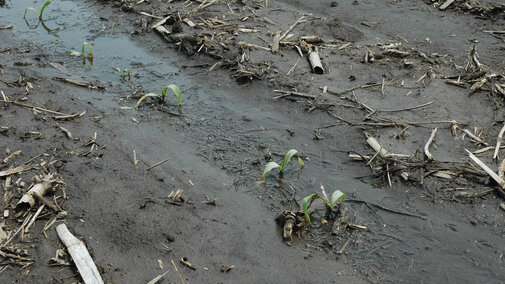Water, water, everywhere,
— Samuel Taylor Coleridge
And all the boards did shrink,
Water, water everywhere,
Nor any drop to drink.
With our fields flooded and soils saturated, these lines from The Rime of the Ancient Mariner by Samuel Taylor Coleridge come to mind. It seems like we’re in that position now across much of Nebraska. How well can freshly planted or emerged corn withstand too much water – albeit “fresh” water, not salt water? With all this water around, is there a drop for corn to drink? Or is it a detriment―undrinkable―as in the case of the ancient mariner languishing in the doldrums of an ocean of salt water?
According to Tuesday’s USDA-NASS Nebraska Crop Progress and Condition Report, 60% of our topsoil across the state has an “adequate” moisture supply and 40% has surplus. Subsoil moisture is rated 72% adequate and 28% surplus. The same report indicates 81% of our corn is planted―behind 94% for the five-year average―and half is emerged―behind 73% average.
With these reports and the fact that water stands on many of those planted acres due to recent heavy rainfall events, many are asking about the impacts of saturated soils and/or standing water on planted and emerged corn. Over the years, CropWatch has published several articles on that question, including one last spring that also discussed nitrogen and disease issues associated with flooded corn. This present article is an attempt to look at some current scientific literature to discover new understandings. We’ll briefly review three publications here―we know that many others exist.

But first, some of what we’ve known and discussed in previous CropWatch stories:
- Water saturation produces anaerobic conditions.
- Both roots and plants need oxygen to respire and survive. Absence of oxygen results in a fermentation process. (See the Kuar et al., 2019, reference for a thorough discussion of the physiological and chemical effects of waterlogging.)
- Anaerobic conditions in soils also can result in denitrification, nutrient leaching, and toxin release by organic and mineral compounds.
- Warmer air and soil temperatures increase the extent of damage.
- Crop development stage at flooding affects plant responses.
- Crop damage increases with the length of flooding.
- Hybrids differ in their responses.
- There is a point of no return for plants.
Also see ...
Replanting Corn: Things to Do and Think About
Flooding Impacts on Germination and Emergence

Chahal and Jhala, 2016, compared glyphosate-resistant hybrid seed (F1 generation) to that of its progeny (F2 generation) with different agronomic and environmental factors to help develop management programs for volunteer corn (F2). We’ll just discuss the responses of the hybrid seed here (F1) although results from the progeny are shown in Figure 3 along with those of the hybrid. Along with several other agronomic techniques, they flooded pots of corn in a greenhouse for 1, 2, 4, 7, 14, and 21 days. Seeds were planted at 1.6 inches (4 cm). Water levels were maintained at 0.78 inches (2 cm) above the soil. Emerged seedlings were counted at 7, 14, 21, and 35 days after planting.
Their results:
- One day of flooding had no impact on seedling emergence.
- Cumulative seedling emergence over the entire 35-day period for the F1 hybrid was reduced by 23%, 95%, and 100% for the two-day, four-day, and greater than four-day flooding treatments. Nothing survived more than four days of flooding (Figure 1).
Waterlogging Effects on Corn Hybrids
Kaur et al., 2019, subjected eight commercial hybrids to 14 or 21 days of waterlogging in a greenhouse experiment when corn was at the V2 development stage to screen and identify hybrids for waterlogging tolerance. Water levels were maintained with a “few centimeters of water ponded above the soil surface (Kaur et al., 2019, p. 3).”
- Soil redox potential, abbreviated “Eh,” decreased daily during the waterlogging treatments (see their Figure 1). Within two days, Eh dropped between 165 and 176 mV and by the end of the study 419 to 452 mV. Initial Eh readings were near 500 mV. The authors help us understand this by stating, “This result indicates that the soil was in anoxic (anaerobic) condition, which makes it susceptible to nitrate reduction to dinitrogen through the denitrification process.” Nitrate reduction can occur with redox potentials between 220 and 280 mV. These levels were reached within two to three days of flooding in this study.
- Soil pH increased from 6.0 to 6.8 during the waterlogging treatments (see their Figure 2). Within two to three days of treatment soil pH increased from 6.0 to 6.4 - 6.5.
- Waterlogging reduced stomatal conductance – a factor associated with stomatal closure. Stomata closure, "…one of the first physiological responses to waterlogging...,” prevents dehydration and absorption of potential toxic ions and reduces nutrient and water demand. (You’ll see in the following that it also reduces chlorophyll and thus photosynthesis too.)
- Chlorophyll readings decreased with increased waterlogging duration. These reductions were evident within five to seven days of treatment initiation (see their Figure 5) and never recovered during what appears to be the 42 days of their study.
- Plant heights with the 21-day treatment were reduced for six hybrids by 24% to 37% compared to the control. Heights of two hybrids were not affected.
- Shoot biomass was reduced by more than 50% with waterlogging for six of the hybrids; these reductions were similar for the 14- and 21-day treatments.
- All but two hybrids had root biomass reductions.
- The final impacts on plants with the 14-day and the 21-day treatments were similar.
Their conclusions:
- “Generally, plants that survive flooding will show new leaf growth in about three to five days with favorable temperatures.”
- Shoot and root biomass, plant height, stomatal conductance, and chlorophyll meter readings decreased with both waterlogging treatments and varied among the hybrids.
- Waterlogging tolerance varies among modern hybrids.
Flooding Impacts on Root Growth
McDaniel et al., 2016, flooded corn planted in a phytotron in cylinders and raised the water level to the soil surface for 1, 3, or 5 days to simulate flooding at development stages V4, V8, V12, and R1. They looked at the impacts of flooding on root responses and root recovery after flooding.
Their findings:
- As the length of saturation increased, root death increased; deeper roots were more likely to die than shallow roots. For example, root mortality for V4 plants in the top 0- to 6-inch zone had 34% and 100% mortality for the three- and five-day saturation periods, respectively. For the 6- to 48-inch profile, mortality for the three-day saturation increased to 53% and for the five-day saturation, 100% of the roots were dead (see their Table 2a).
- Root elongation rapidly decreased with saturated soils and all root growth stopped within 24 hours of flooding. Although they attained a fraction of the control’s growth rate during the first one or two days of recovery, flooded roots sometimes attained the same growth rate as the control during the post-flooding recovery period.
- Rooting depth was not affected by one day of flooding; however, beyond that, the older the plant at flooding, the more effect there was on rooting depth for the entire season (see their Figure 2), with the exception of the five-day flooding at V4. Maximum rooting depth for the five-day flooding at V4 was 10 inches (254 mm) shallower at the end of the season than the control. The R1, five-day treatment was 18.6 inches (473 mm) shallower than the control.
- Root mass was affected neither by a single day of flooding, nor by three days of flooding at either V4 or V8. However, three or five days of flooding at either V12 or R1 reduced root mass for more than 35 days. Flooding for five days “significantly” affected root mass at V4, V12, and R1, but not at V8.
McDaniel et al., 2016, summary:
- The longer a plant root is flooded, the greater the injury potential.
- Three to five days of flooding negatively affected root viability, mass, and maximum depth.
- Plants at V4 were very susceptible to damage when flooded for five days.
- Plants at V8 were more tolerant of flooding than the others tested.
- Roots of plants flooded at either V12 or R1 were never able to fully recover either their root mass or rooting depth.
| Stage | Condition | Potential for Survival and Problems |
|---|---|---|
| Before emergence | Germinating seeds with flooded soils | Genetic differences exist among hybrids and inbreds for responses to flooding. A single day of flooding had no impact on emergence, but cumulative seedling emergence over a 35-day period for a hybrid was reduced by 23%, 95%, and 100% for 2-day, 4-day, and greater than 4-day flooding treatments. No seeds germinated and emerged after more than four days of flooding. |
| Corn flooded at V2 for 2 or 3 weeks | Water levels maintained a few centimeters above the soil surface – greenhouse study | Flooding resulted in: • Soil redox potential decreases―a result of anaerobic conditions • Soil pH increases • Chlorophyll decreases without recovery • Decreased plant heights and shoot and root biomass. • Some variation among hybrids |
| Corn prior to 6th leaf stage | Underwater (6 inches of water on surface); air temperature less than 77°F Saturated, cold soils, flooding |
Survival for four days. Longer flooding resulted in lower yields, especially at lower nitrogen levels. Some plants will be buried by sediment and residue and may not survive. Seed rots, seedling blights, various other pathogens, crazy top |
| Corn flooded for 1, 3, or 5 days at V4, V8, V12, and R1 | Water raised to the soil surface and maintained for the treatments -Phytotron study |
|
Summary
The new research articles reviewed here do not address yield potential, but substantiate the points in previous CropWatch articles. They describe plant responses in terms of germination and stand establishment, soil responses, the physiological impacts of flooding on plant physiology, and they present a clear representation of root responses.
Essentially, as corn stands in a saturated, waterlogged, or flooded soil, the plant goes into a defensive mode from which―depending on the timing and duration of the flooding―it likely will never fully recover. All that water, and the plant shuts down―as with the Ancient Mariner.
References
Chahal, P.S. and A.J. Jhala. 2016, Factors affecting germination and emergence of glyphostate-resistant hybrid corn (Zea mays L.) and its progeny. Canadian J. of Plant Science. 96(4): 613-620.
Kaur, G. N., B. Zurweller, P.P. Motavalli, and K.A. Nelson. 2019. Screening corn hybrids for Soil Waterlogging Tolerance at an Early Growth Stage. Agriculture. 9, 33; doi:10.3390/agriculture9020033
McDaniel, V., R.W. Skaggs, and L.M. Negm. 2016. Injury and recovery of maize roots affected by flooding. Applied Engineering in Agric. 32(%0:627-638.
Timmerman, A., T. Jackson-Ziems, R. Elmore, T. Williams, and B. Krienke. 2018. Flooding and Ponding in Corn. CropWatch. June 22, 2018. https://cropwatch.unl.edu/2018/flooding-and-ponding-corn

